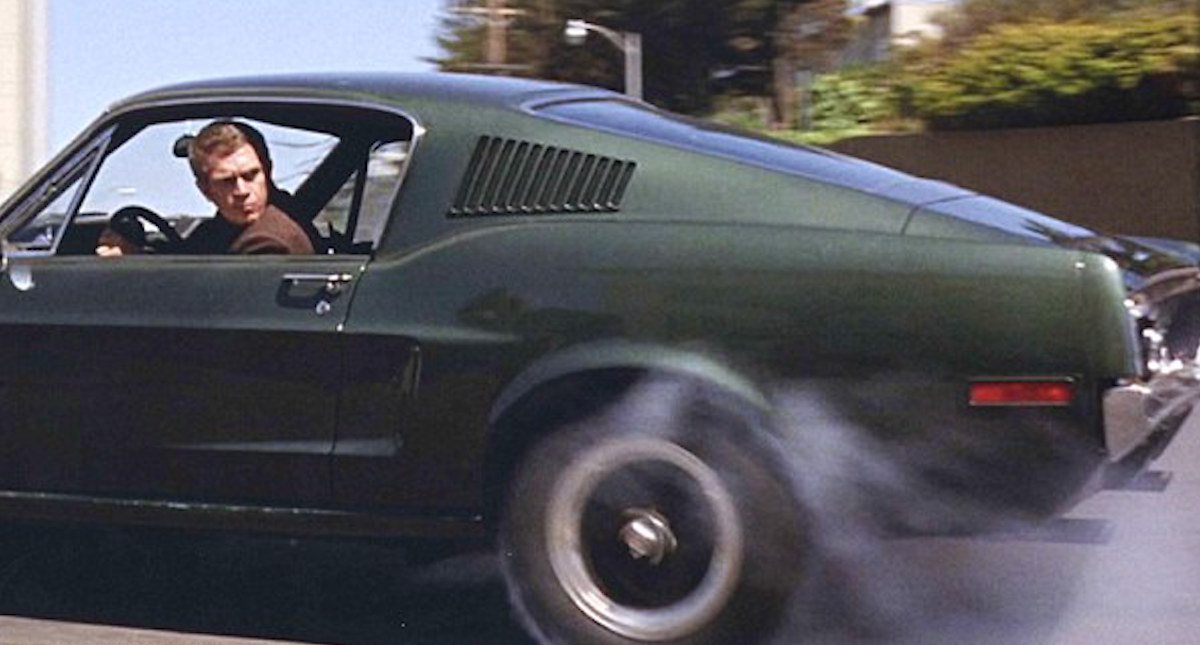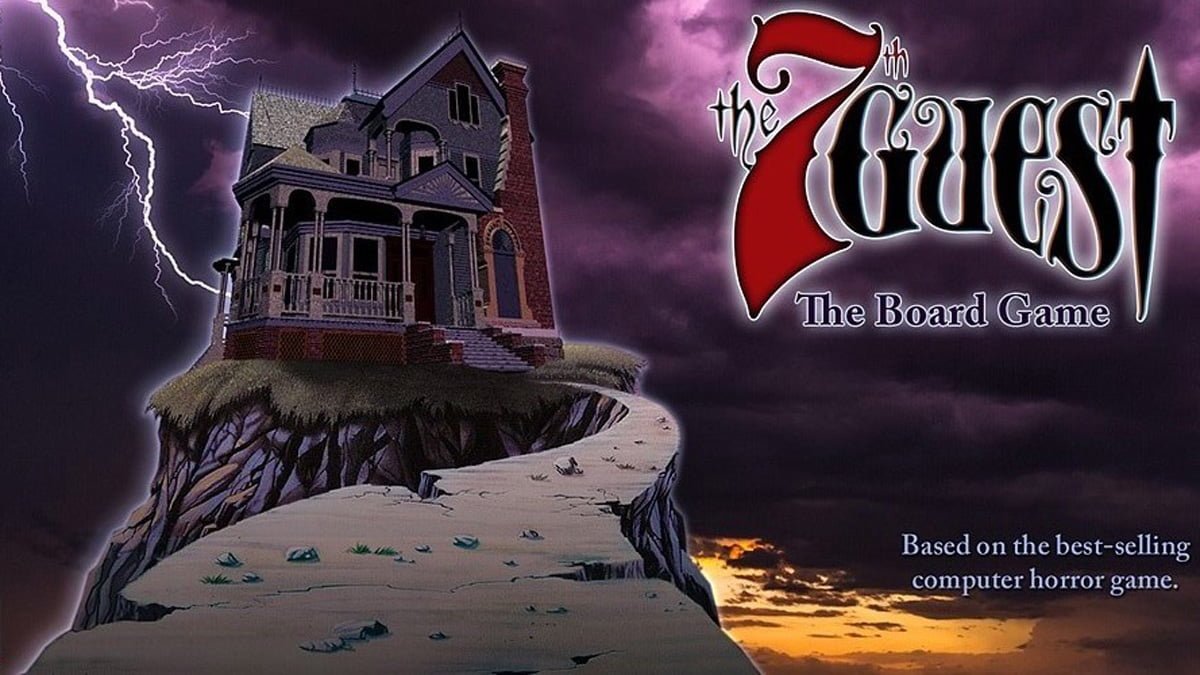
What Is The 7th Guest?
The 7th Guest is a board game based on the 1993 video game of the same name. The original video game is a cult favorite and often remembered as one of the first games ever released on CD-ROM and also one of the first to contain cinematic cutscenes. The board game attempts to recreate the sinister vibe of the original through puzzles and miniatures based on the game characters. Please note: This post contains affiliate links.
Components
- 7 Miniatures
- 36 Mystery Spell Cards
- 108 Destination cards
- 300 Puzzle Cards
- Magic Decoder Window
- Magic Die

How Do You Play The 7th Guest?
Setup
To begin a game of The 7th Guest, players pick which of the six character miniatures they wish to be. The optional Ghost figure is placed to one side or left in the box if you will not be playing with her. Players then place their figures on the start space. The cards are separated into Destination, Puzzle, and Mystery Spell stacks and then shuffled. The Puzzle and Mystery Spell stacks are placed to the side of the board while the Destination cards are distributed between players with the number given to each player determined by how long you want the game to last.
- The Grand Tour – 18 Destination Cards
- The Dime Tour – 10 Destination Cards
- The Nickle Tour – 5 Destination Cards
Players place their stack of Destination Cards in front of them and turn over their first card. This will be their initial destination. Any remaining cards are returned to the box and the game is now ready to play.
Gameplay
The first player rolls the Magic Die and moves the number of spaces indicated. If they land on a blank square then play passes to the next player, if they land on a Mystery Spell space they take a card and follow its instructions, and if they land in the room on their first destination card, they have the opportunity to solve a puzzle.

Mystery Spell Cards and The Ghost
Mystery Spell cards work similarly to Chance or Community Chest cards in Monopoly, by creating actions and events that alter the course of the game. The cards include actions such as taking an extra turn, moving yourself or another player to a specified location in the house, or magically solving a puzzle. If you have chosen to play with the Ghost, you may become the Ghost or be released from her hold through Mystery Spell cards.
You may also become the Ghost by being tagged by her. If another player has already become The Ghost and you land on the same spot as her, you are tagged and become the Ghost, which frees the other player. However you become the Ghost, your miniature is replaced by hers, and you must now wander the halls until you either tag an opponent or draw the Mystery Spell card to free yourself. Playing with the Ghost is optional and we didn’t bother playing with again after our first game with her because we found that the Ghost detracted more from the game than she added to it.

Puzzles
Whenever you reach one of your destinations, you automatically get to solve a Puzzle. Another player will read out the question and show the card to everyone (many of the puzzles have visual elements) as well as announcing how many (if any) hints are available.
The current player gets to take the first guess. If they answer correctly, they discard their current destination card and reveal the next one in their stack. If not, the next player gets to take a guess and so on around the table until everyone has attempted to steal the card and discard their current destination. If the current player did not correctly solve their puzzle they must stay in the room and wait until their next turn to attempt to solve another puzzle.
Once a player has solved a puzzle in their final destination room and discarded their final Destination Card, thus emptying their stack, they are immediately transported to The Little Room at the Top where they must attempt to solve a final puzzle. Failing to solve this puzzle has the same consequences as solving one in any other room, but the first player to solve a puzzle in The Little Room at the Top wins the game.
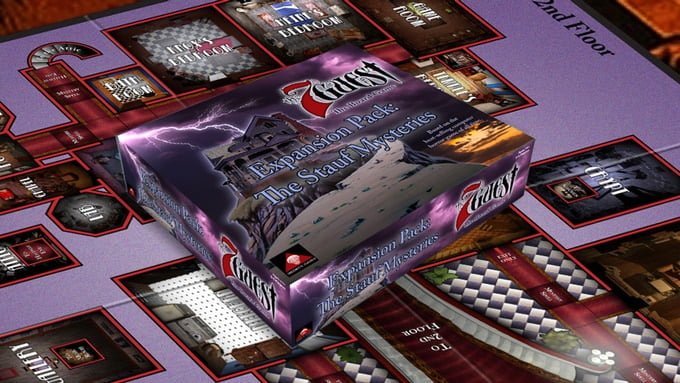
Expansion
An expansion to The 7th Guest was announced and funded via Kickstarter earlier this year. Named The Stauf Mysteries, this expansion adds nine self-contained mysteries that, when added together, “tell part of a much larger story, further enriching the saga and backstory of the mysterious world of Henry Stauf, the people of Harley on the Hudson, the seven guests, the Lady in White, and much more.” It is the first of multiple planned expansions to the game.
With 171 Mystery Story cards included, this expansion seems as if it will add a lot of interesting story elements to the game, however, I can’t help but feel as if this is what should have been included in the base game to begin with.
Should You Buy The 7th Guest?
In a nutshell: probably not. The 7th Guest board game is, objectively, a poor game. In terms of strategy, there is nothing more to it than roll and move, and many of the puzzles seem to have been scraped from the internet, so you may well have seen them before. If you are looking for a strategic game, you are going to be utterly disappointed by this.
However, if I remove my tabletop gamer hat for a short while and replace it with my 7th Guest-loving nostalgia hat, The 7th Guest starts to look a little better. The board alone evoked strong memories of the hours I spent wandering around Stauf’s creepy manor trying to figure out solutions to his puzzles, and the miniatures are surprisingly good likenesses of the characters they represent. Sure, the roll and move element is still terrible, but that is easy enough to fix by assigning the same set of room cards to all players instead and by replacing rolling the die with the choice of either a “move to new room” or a “solve puzzle” action at the start of each player’s turn. Of course, this means forgoing the use of the Magic Die, which, although odd in its numbering, it probably the prettiest single element of the whole game.
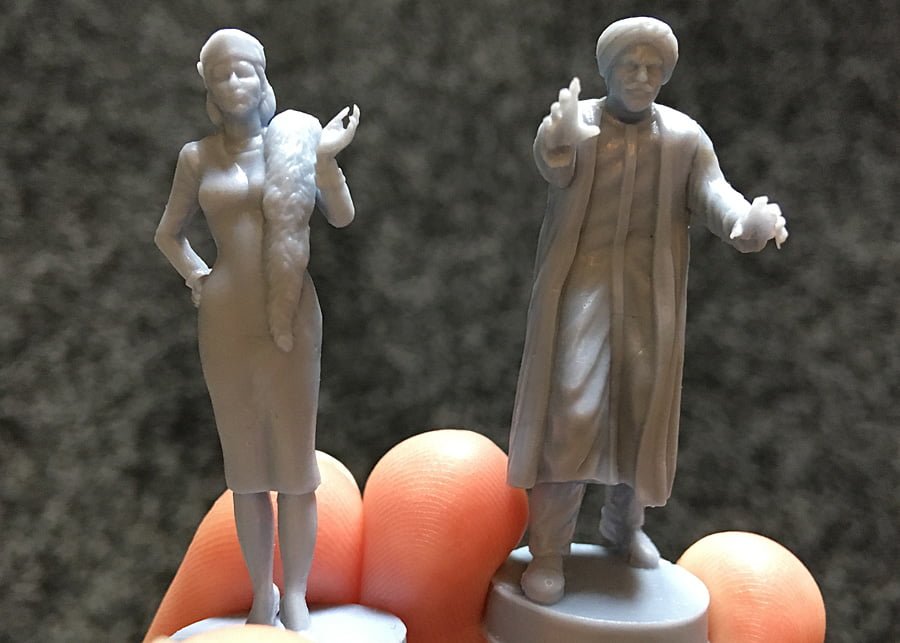
Returning to the miniatures, I must note that my production copy of the game was missing one figurine entirely (instead I had two copies of another) and two of the figurines were missing arms which had snapped off inside the box. This is most likely because the box insert that holds the components was much too small, meaning that everything had been thrown around inside during transit—even the insert itself was crushed and the Magic Decoder was damaged too, although still usable. Reading over the comments on the Kickstarter, this problem was not unique to me, with many backers also reporting damaged miniatures and boxes, something which could have been avoided with more care paid to the inserts. Those miniatures which survived intact were impressive and it was obvious who each one was supposed to be. On the upside, the developers offered to replace my set of miniatures, and the replacement set arrived complete and undamaged, which is fairly miraculous given that the packaging used to ship them left a lot to be desired.
As for the puzzles, while many were familiar and the use of copyrighted material in the game questionable (such as a card with a movie still taken from The Shining), there were actually some good puzzles here. I especially liked the math questions, which I often challenged my nine-year-old to solve away from the game as a whole and there were several that had me stumped, even after resorting to using hints. One thing I really didn’t like was the decision to include trivia questions related to other pop culture properties as puzzles. First, these are not puzzles in the style and spirit of the original video game, and second, I found these questions immediately pulled me out of the universe the game was trying to immerse me in. Many of the intellectual properties the cards referred to hadn’t even been released when The 7th Guest was first released, let alone during the era in which the story is set. Finally, I would have liked to see a separate stack of trickier puzzles just for The Little Room at the Top instead of these puzzles simply being drawn from the regular stack.
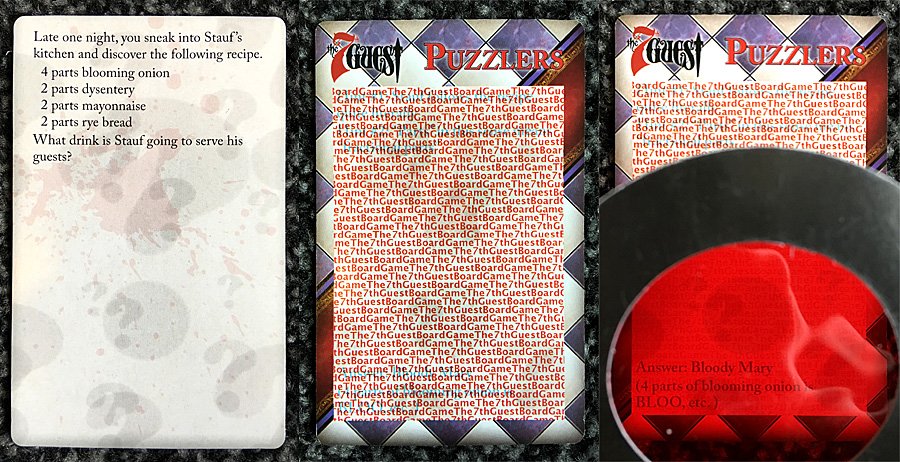
We did also find one major problem with the puzzle cards, which was with the way the answers are revealed. The backs of the puzzle cards are printed in such a way that the answers can only be seen by holding the red Magic Decoder over them. It’s an old magic trick, but one that we quickly learned does not work for everyone. When playing with my mother, she was simply unable to read the text through the decoder despite her not having any known vision problems that could account for this. I have so far not been able to have a colorblind friend test the cards, but this has made me wonder how accessible the game is to players with vision problems.
Summing up, I’m sad to say that this is a weak game that will most likely only appeal to die-hard fans of the original 7th Guest video game. For those fans (like me), there’s an enjoyable nostalgia trip hidden inside this version of Stauf’s mansion, but for everyone else, this is a game with very little substance to it and one I can’t in good conscience recommend.
GeekMom received a copy of this game for review purposes.


